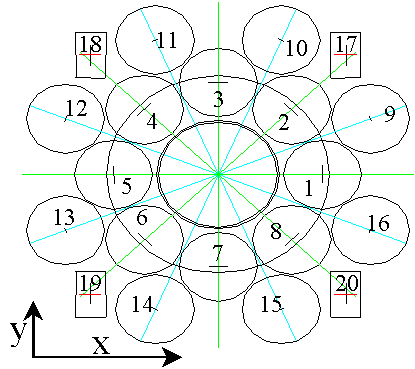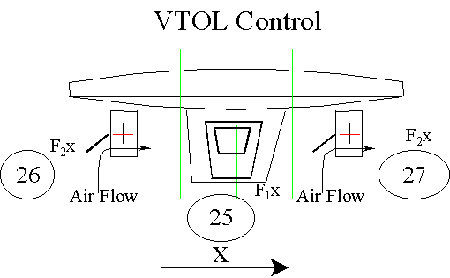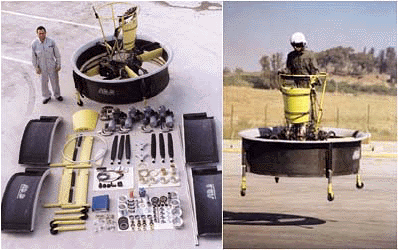Original URL: https://www.theregister.com/2001/06/07/indian_flying_car_shot_down/
Indian flying car shot down – Israeli rival soars
Never even got off the drawing board
Posted in Bootnotes, 7th June 2001 13:36 GMT
Our recent piece on Indian boffin Rakesh Goel's boast that he will put a flying car into the air by 2004 provoked much discussion among Reg readers.
Naturally, many of you were sceptical that such a feat could be achieved. Well, we have managed - with a little help from our fellow flying car fans - to track down the plans and technical specifications for this mechanical wonder.
 |
According to its inventor, the above plan shows "twenty electric motors which drives twenty propellers. Sixteen motors and propellers generate vertical thrust and are named as Vertical Thrust Motors (VTM) while remaining four motors and propellers generate horizontal thrust and are named as Horizontal Thrust Motors (HTM). All the thrust motors are Permanent Magnet Synchronous Motor with single sensor (PMSM) which are driven by separate electronic drives. A Piston powered/ Turbo Shaft Engine and Alternator is used to generate and feed necessary electrical power to all electronic drives and motors."
 |
How, you were wondering, were they going to keep this glorified frisbee stable? The above diagram shows that: "Four stabilizers are used on each HTM which functions as horizontal as well as vertical stabilizer for flight control. At least two of the four HTMs are operated in reverse direction during takeoff and Landing to compensate all horizontal thrust generated by engine exhaust or any horizontal component of VTM thus ensuring true Vertical Takeoff and Landing."
The use of electric motors is an interesting concept... That aside, the state of the drawings leads us to believe that this magnificent contraption will not be soaring majestically into the skies above Mumbai in the foreseeable future.
For all you propellerheads , the technical specifications are:
- Type of Thrust Motor: Permanent Magnet Synchronous Motor with single sensor
- Number of Motors with propeller: (a) 16 nos. for Vertical Thrust (b) 4 nos. for Horizontal Thrust
- Engine capacity: Piston powered/Turbo Shaft engine of 200 HP
- Alternator Capacity: 150 KVA
- Max. Flight Duration: 1 Hour
- Altitude range: 1200 m (4000 feet)
- Max. Speed: 50 KPH (30 knots)
- Total weight of Flying Car: 500 Kg
- Payload Carrying Capacity: 100 Kg
- Dimensions: 5.2m x 5.2m x 2.1m
Whether or not the Indians, or US company Moller Industries for that matter, ever come good on their flying car promises, we are finally in a position to announce a machine which is available right now.
 |
If you've got a few bob and 250 hours construction time going spare, you too can be the proud owner of a kit 'Hummingbird' flying platform.
The Israeli inventors claim that "This remarkable flying machine was developed with the aim of creating the world's first truly simple to operate and safe personal VTOL (Vertical Take Off & Landing) vehicle. Inspired by an original idea by the 'Hiller' company in the US dating back to the 50s, the design is based on a 'ducted fan' powered by four small internal combustion engines. The person standing on top controls the vehicle by merely shifting his/her weight. Learning to fly is easy: If you can ride a bicycle - you will be able to fly the Hummingbird."
But what happens if you lean out to wave to the kids on your way to work? Mercifully, the Hummingbird offers "a ballistically deployed emergency parachute unit" as an optional extra. Would Sir like alloy wheels and sunroof? No thanks, I'll take the parachute unit.
The Hummingbird flying platform measures up thus:
- Width/Diameter:2.2 m (7.2 ft)
- Height: 1.9 m (4.2 ft)
- Empty weight: 145 kg (320 lbs)
- Max. Gross weight: 260 kg (572 lbs)
- Fuel capacity: Basic tank 19 liters (4.8 gal)
- Engines: Four Hirth F33-15A; Single Cylinder; 22hp
- Electric start by ground assistance
- Max. speed: 40 kts
- Max hover height: 5000 ft
- Endurance: 30min
We would very much like to hear from anyone who has built and operated a Hummingbird. Or from their executors. ®
Related links
The Indian flying car from SK Dynamics
The Hummingbird VTOL personal transport solution
Related stories
So, where is my flying car?
Skycar crashes and burns?
Flights of fantasy
India to levitate flying car